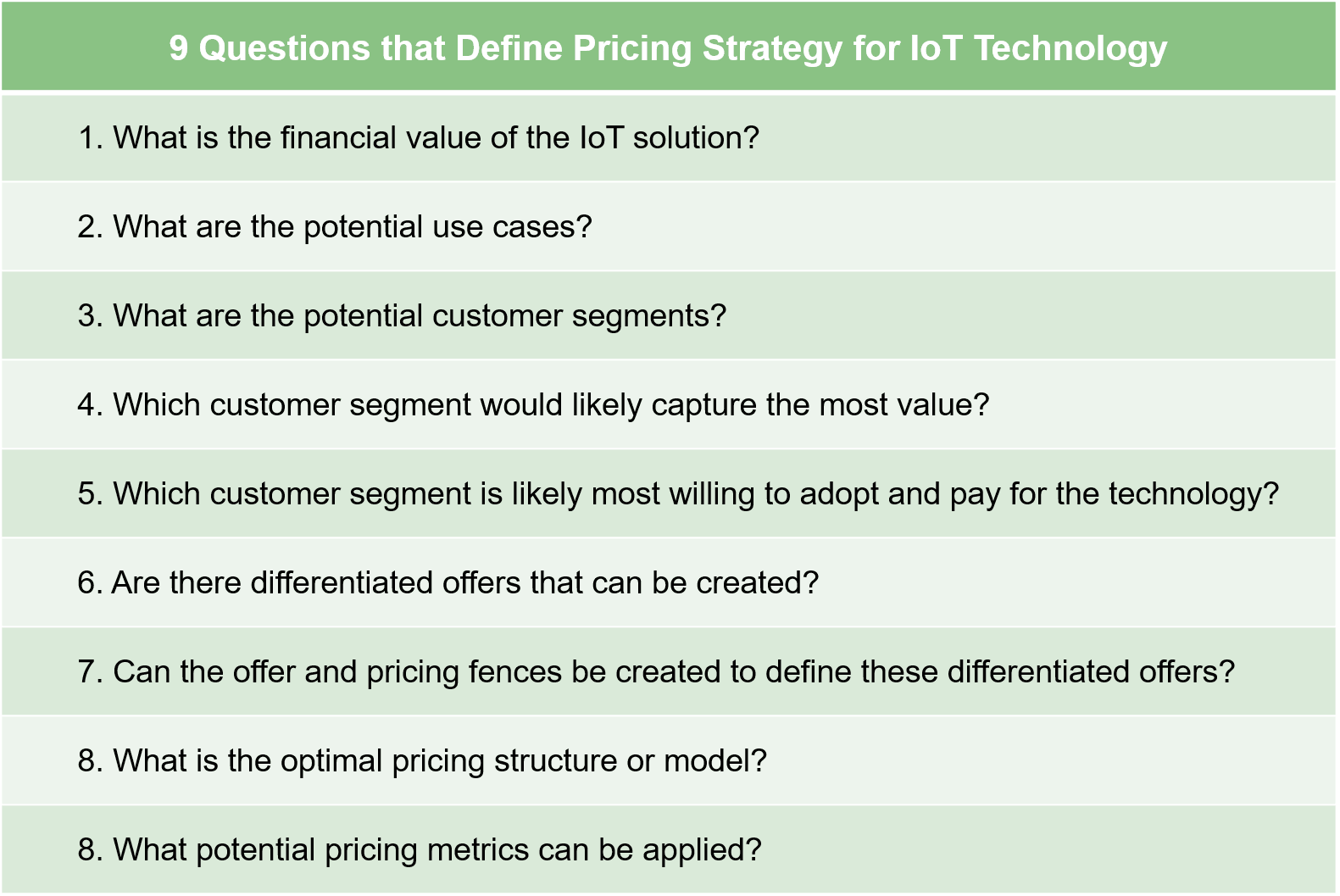By Greg Thomas, Vice President of Pricing Research & Insights and IoT Expert at Pricing Solutions
The Internet of Things (IoT) revolution is changing the landscape of business, with new product innovations springing up in a wide range of industries. While IoT technology is generating huge business opportunities, it is also creating a significant challenge – how can businesses effectively monetize Internet-of-Things products and not leave money on the table?
How to Capitalize on the Internet of Things
When it comes to the Internet of Things and, in general, to new innovations and technologies – there is a high risk of failure, especially when:
- Market research is not conducted
- Businesses over invest in development and underinvest in sales
- The product is interesting, but lacks a precise market
- The product’s key differentiators and advantages are not easily articulated
- The product is not scalable or configurable.
All of these challenges can be addressed through research and by engaging with customers to better understand how they may use and apply the technology. Firms that don’t invest the time it takes to research and develop their technology to overcome these challenges end up with a weak positioning and communications strategy. For this reason, this research is critical and should be done early in the development stage of a technology.
Align Your Tech with Customer’s Potential Usage and Value Expectations
Rather than develop less than optimal configurations or offer structures that lead to questionable pricing strategies companies should step back and focus on the value offered to the customer.
The Pricing Solutions team has worked with a variety of clients across different industries, and in our experience the alignment between the customers potential usage and their value expectations relative to the pricing model is crucial. In other words, we recommend developing a pricing model that’s aligned with how customers will use the technology and how they’ll experience the value of the technology.
You may be interested in this Case Study:
Launching a Breakthrough IoT Product with a Customer-Centric Pricing Strategy
Consider Internal Constraints
There are also internal challenges and constraints that go beyond understanding how the customer may value the technology. These constraints and challenges often impact the overall success of the technology and the pricing model that’s developed from it.
One of these common challenges is centered around internal alignment. Often there is a convergence of different technologies and skills to develop the overall solution. For some firms these different technologies and skills are inherent, while in other cases they have been acquired from other firms or from different business units. In either case, the end result is that there are different goals and objectives by the business units or acquired firms, which creates a challenge in aligning on the measurement of success. When there are different metrics in play to measure success, a cultural challenge often ensues regarding how to align on what’s optimal from a pricing perspective.
Developers of a technology may also encounter channel constraints. These companies might be selling through a channel or selling directly and through a channel. So, there can certainly be challenges with how to go to market and how that may relate to the pricing model that was structured for the technology.
As companies go to market with their technology it’s important to be aware of and to address these internal constrains and develop a communication strategy or positioning strategy in addition to a pricing strategy that accounts for these challenges.How to Price the Internet of Things
With these challenges in mind, how do technology companies capitalize on the IoT through thoughtful pricing? We recommend beginning by considering nine key pricing strategy questions that you need to have answers to before building the framework of your pricing strategy for your IoT technology.
The Pricing Solutions team has developed these nine questions over time and these questions really help us get to the heart of the matter of what we need to understand as we’re moving towards developing a pricing strategy for customers who are going to market with a new technology.

-
What is the financial value of the IoT solution?
This is a big question. There may be different value propositions depending on the market and the customer, the scale and the solution that’s applied.
-
What are the potential use cases?
What are the potential use cases related to understanding the financial value of the technological solution? In other words, do different customers apply the solution in different ways? To answer this it’s important to understand whether customers:
-
- Use the technology differently
- Produce different things with the technology and if so, if the things produced for one customer are more valuable to them compared to others customers
- Place different value on the technology based on how they use it and the return on investment it offers them.
-
What are the potential customer segments?
Understanding your customer segments is very important in the development of a pricing strategy for any product or service, but especially for IoT technology. Customers might be segmented by: Market, Industry type, Size of customer, Device size, Use case
Read more on this topic: Segmentation Should be Your Pricing Backbone
-
Which customer segment would likely capture the most value?
This relates to the question we asked earlier about the use cases. It’s important to understand how customers use the technology and how they capture value from the application of the technology.
-
Which customer segment is likely most willing to adopt and pay for the technology?
This is very important in understanding how to market and where the company should prioritize its time and effort in this complicated transaction.
There’s a lot of education that will likely happen with the customers, there is probably limited resources and communications to customers and hands on selling to customers. The company needs to understand if there’s differences in use cases and differences in value that could be captured from customers, and prioritize the customers based on whether one group is more willing to adopt and pay for the technology than another.
Businesses might scale down to other use cases and other customer segments to capture as much value from those who are less willing to pay, but it’s important to start and launch with the customers that are more willing to pay. We recommend companies price to that segment of the market as they launch their new technology.
-
Are there differentiated offers that can be created?
This is a big question and a complicated one to answer. A one size fits all approach may be a challenge as a company tries to scale the offering to other types of customers. If so, consider whether it’s possible to configure the solution in ways that are differentiated to increase value. This may mean adding differentiated rates for different types of customers.
-
Can the offer and pricing fences be created to define these differentiated offers?
Consider whether it’s possible to configure the offer in different ways, knowing that the offer may be attractive to one set of customers and not attractive for another set of customers. When considering this it’s important ask whether the company has the capabilities to:
-
- Understand what the differentiated value would be and how to price for it.
- Execute differentiated offers as the technology goes to market
- Host and manage internal systems capable of pricing differently for different customers under different configurations of the solution
-
What is the optimal pricing structure or model?
This is another big question to answer as companies go to market with the Internet of Things. Consider the pricing of the transaction. Is it a capital expenditure and across the spectrum a purely operational expenditure? It’s important to understand how customers want to conduct the transaction and whether they want to purchase it in a conventional manner. Specifically, whether they want to license, lease or subscribe to the technology.
-
What potential pricing metrics can be applied?
Tracking metrics around the transaction provide the capability to monitor customer usage and employ different pricing models more effecitvelyto leverage pricing opportunities.
Often, we suggest employing different pricing metrics based on the pricing model. Within the software industry the model is often a license and a price per computer per person, but within the equipment manufacturing industry pricing may be based on per unit produced or per square foot of the facility. All kinds of different metrics may be applied. Check out our webinar to learn more about choosing the right pricing metrics.
Ultimately, when considering how to monetize the Internet of Things, businesses need to start by answering these nine key business questions and use the answers to shape their pricing strategy. These questions may differ across different types of solutions or types of business, but cover the essence of what should be answered when considering price.





